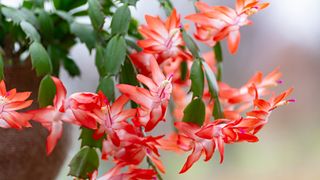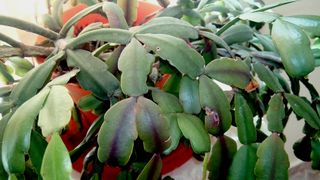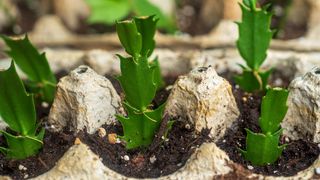It’s not just its name that makes the Christmas cactus such a beloved choice for holiday decor. This cactus flowers through December each year, adding much-needed color and vibrancy when most plants are in their dormant period. With its long, segmented stems that hang dramatically downwards and its red, pink, white, or purple flowers, the Christmas cactus makes for an attractive gift this time of year, just like a poinsettia — but it’s not just a seasonal item. With the right care and attention, you can enjoy this plant throughout the rest of the year.
As the holidays wrap up and the new year begins, look out for signs that your Christmas cactus may be coming to the end of its flowering season. Then, instead of throwing it out, follow these steps to ensure it’s in good shape for next year’s holiday period.
Post-holiday care

When you notice some of the blooms are beginning to die off, take some time to deadhead the cactus with a pair of clean pruning shears. Not only will this improve the look of the plant but it will also encourage it to produce more blooms, if it’s still in its flowering season. Be sure to remove any dead flowers gently to minimize any damage to the stem.
Once the flowering season is fully over, which will likely happen at some point in January, it’s time to shift toward dormancy maintenance. Unlike other cacti, the Christmas cactus is a succulent and, therefore, thrives in a warm, humid environment. Make sure you keep the plant at temperatures of 60-70°F throughout the remaining winter months; don’t move it outside until night time temperatures are consistently above 50°F.
While Christmas cacti benefit from regular watering, you can decrease this once the flowers have all died, as they will not need as much energy as when flowering. Keep the cactus in a well-draining pot and water until moisture runs out of the bottom. Then, wait until the water has fully drained and empty any that has collected on the saucer below, before returning it to its place. Allow the soil to almost dry out before watering again, but remember that this cactus will not enjoy arid conditions.
Keep the plant in a location where it receives a few hours of bright yet indirect light a day. Too much sunlight and the foliage will burn, so watch out for any overexposure. Since the cactus will be in its dormancy, it won’t need as much light as at other times of the year.
Spring and summer care

As temperatures begin to rise, the Christmas cactus will enter its growing period. Now is the time to start introducing fertilizer on a consistent schedule, with an aim for every two or four weeks. As flowering won’t occur until November or so, use a half-strength mixture and avoid any fertilizers with a high phosphorus content.
Between May and June you might need to prune back any of the leggier stems of the cactus. To do so, gently sever the plant along one of the clear segmentations to minimize damage to the plant. This will actually encourage the plant to grow more. It’s particularly important if you want the Christmas cactus to bloom again come wintertime. You may choose to propagate these cuttings or simply dispose of them if one cactus is enough!

Once outdoor temperatures are warm enough overnight, you might choose to move the cactus outside. However, an indoor environment is also fine for growth. Make sure to rotate the pot a few degrees every few days — this allows the plant to grow evenly and prevents it from growing at an angle toward the sunlight. You will want to place the cactus where it can get several hours of bright, indirect sunlight a day.
During this period, you should be rewarded with happy growth of the segmented stems, which should cascade over the planter’s edges. This makes for an attractive addition to the garden or home, even without the signature flowers.
Winter blooming

If you do want to see those vibrant flowers again come winter, you’ll need to change the cactus’ conditions to promote their growth. This means giving the cactus at least 12 hours of pure darkness each night; a garage or basement will be much more effective than other rooms of the house, which may see more direct or indirect light. The night time temperatures should also be low, at 55°F and no higher than 65°F degrees. Then, you will need to move the cactus into a sunny spot each day for an additional 10 hours of sunlight.
This schedule of 12 hours of darkness and 10 hours of sunlight (with two hours of flexibility) will help the flowers bud. You should begin this schedule approximately 6-8 weeks before Christmas and continue it until the buds form. Then, you can keep the plant in a nice visible spot over the holidays and enjoy the flowers — just make sure there is sufficient light to keep the flowers happy.
More from Tom's Guide
- Discover How to care for an amaryllis
- And 7 clever ways to reuse your real Christmas tree after the holidays
- Plus, 9 winter flowers you should plant right now for a vibrant Christmas garden




![Online Shopping Reached New Highs in 2024 [Infographic]](https://imgproxy.divecdn.com/kCw9rTPPHoCqXkkL4Bt8p7eohxOuRs6iXsDK03Fxr_8/g:ce/rs:fit:770:435/Z3M6Ly9kaXZlc2l0ZS1zdG9yYWdlL2RpdmVpbWFnZS9vbmxpbmVfc2hvcHBpbmdfc3VyZ2UyLnBuZw==.webp)















)
 English (US) ·
English (US) ·